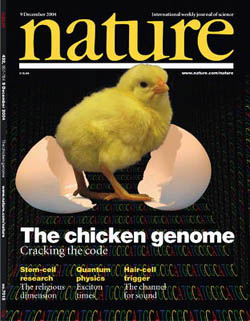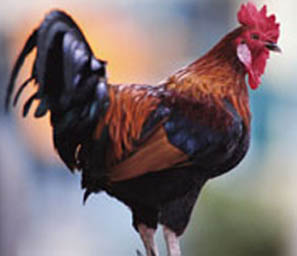

After completing the work on mapping chicken genome sequence and chicken genome variation in early March, 2004, two international research consortiums have made significant progress in reading the maps, shedding new light on the studies into the first bird as well as the first agricultural animal that has its genome sequenced and analyzed in the world.
In the Dec.9 issue of the journal
Nature, the two teams reported a sequence analysis on the Red Jungle Fowl (
Gallus gallus), which is the progenitor of domestic chickens, and a genetic variation analysis between three domestic breeds with their wild relative. Researchers from the CAS Beijing Genomics Institute (BGI) are actively involved in the projects and play a leading role in the work of the chicken genome variation map while the Chinese Academy of Sciences (CAS) is among dozens of financial supporters from various countries for the two projects.
After a carefully genomic comparison between chicken and organisms that have already been sequenced, including the human, the International Chicken Genome Sequencing Consortium discovered that although the chicken genome contains considerably less DNA, it has about the same number of genes, and about 60% of chicken genes correspond to a similar human gene. Researchers also identified a chicken counterpart to an important human immune system protein, revised scientists' assessment of the chicken's sense of smell, and suggested that the chicken, long used to study gene activity in the earliest stages of life, may provide a good model for studying changes in DNA linked to aging and death. Other findings from the analysis include the identification of genes that affirm the chicken's value as a model for study of developmental disorders like cleft palate and diseases like muscular dystrophy.
As a complementary work to those of the Chicken Genome Sequencing Consortium, an International Chicken Polymorphism Map Consortium reported their findings in the same issue of
Nature. The variation map was derived from three different domestic chicken strains, consisting of a broiler strain from the United Kingdom, a layer strain from Sweden, and a Silkie strain from China. Total one-fold genome coverage of sequences was produced for this map and was evenly divided among the three domestic strains. About two million single-nucleotide polymorphisms (SNPs) were identified. In contrast to the idea that domestic animals are more highly inbred than their ancestors, the study detected a startling amount of genetic diversity in the tree strains as compared with their ancestor, the red jungle fowl.
Experts say that those studies could fill a crucial gap in people's scientific knowledge. In addition to its tremendous value as a resource for comparative genomics, the chicken is widely used in biomedical research. It serves as an important model for vaccine production and the study of embryology and development, as well as for research into the connection between viruses and some types of cancer. The data should help us understand better our own biology and may give us fresh insight on avian-borne diseases such as salmonella and bird flu, which is in the limelight of the public concern nowadays.
The study of chicken genome polymorphism is significant for developing high-grade chicken breeds in China, which is an original area of chicken and retains a large amount of breed resources, according to BIG scientists. The chicken genomic variation sites identified through the sequencing work will be applied directly in chicken genetic breeding that will improve the upgrading of chicken's productive character, and at the same time raise the research level in animal hustandary.






